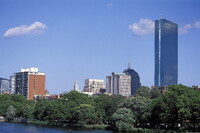John Hancock Tower
Pei, I. M.

Download1A1-PI-JH-B1_cp.jpg (534.2Kb)
Date
1976Description
General view, looking southeast over the Charles River, showing location in the Back Bay; Ever since Mies Van Der Rohe proposed a glass skyscraper for Berlin, modern architecture has been working toward the vision of the tall, skinny glass box. A few modern architects tried for that vision, and we have Lever House and the Seagram buildings in New York by Gordon Bunshaft and Mies himself, respectively, as well as the Johnson Wax Research Tower by Frank Lloyd Wright. But nobody got that glass wall down to almost invisible, the Holy Grail of modernism. There was always too much mullion, or too much structure showing. In 1972, Pei's firm finally managed to pull it off with the Hancock Tower in Boston. Pei wrapped up the modern movement and tied it up with a bow in that building. The tower is an achievement in minimalist, modernist skyscraper design. Each bay of each floor is a single pane of glass; there are no spandrels between the floors and the mullions are minimal. In a stroke of genius, Pei took the rectangular floor plan and made it into a parallelogram, so that from the most common views, the corners of the tower were even sharper. You expect the corners of a skyscraper to be square and those acute angles make it seem like it is standing on point shoes. The reflective glass is tinted blue, so on a bright day it is just a bit of transplanted sky, a giant slab of Magritte in the Boston skyline. For a final touch, he added a pinstripe of geometry to the shorter sides so they would always reflect a different piece of the sky, emphasizing the vertical lines. Source: Wikipedia; http://en.wikipedia.org/wiki/Main_Page (accessed 2/10/2008)
Type of Work
office building; skyscraperSubject
architectural exteriors, business, commerce and trade, contemporary (1960 to present), Modernist
Rights
Rights Statement
Licensed for educational and research use by the MIT community only